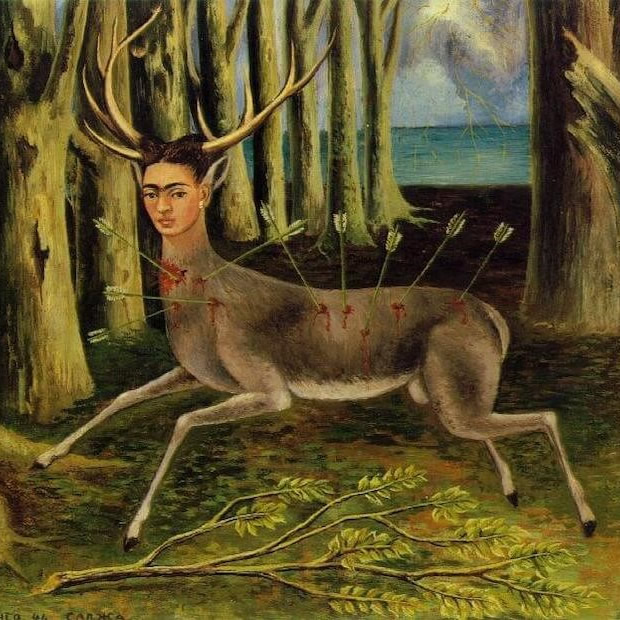"The Wounded Deer" 1946 - Maria T.


Description:
Frida Kahlo used visual art to express her feelings and tragic life experiences. Sexuality themes include loneliness, infertility, miscarriage, divorce, bisexuality, sexualisation, and submission. Disability themes include fatal injuries, loss of bodily autonomy, chronic pain, and depression. There are motifs in Frida’s oil paintings such as Skeletons, flowers, and deer.
Significance:
I chose this artefact because I believe Frida is an excellent depiction of the suffering that exists with life as a disabled person. Throughout her career, Frida Kahlo travelled and attended public events outside of her hometown of Coyocan, Mexico despite having chronic pain. Frida harnessed her emotional dread into the medium of oil paintings consisting of mainly self-portraits and other Mexican-inspired backgrounds. I was interested to know how her disability affected her view of sexuality. Frida had a tragic and prolonged relationship with Diego Rivera where they divorced and remarried shortly after due to several affairs and unfulfilled expectations. This romantic entanglement with Diego had shaped her understanding of the role of gender, reproduction, sexual orientation and sexualisation. As a child, Frida would not typically participate in gendered stereotypes. She had short hair and played various sports. Frida’s masculinity was condemned by her love interest, Diego. She felt as if she had to perform her gender to prove that she was consistent and submissive to his demands. Frida has depicted herself as a wounded deer in the artefact which correlates with her longing to escape. This abstract view of her body belonging to a deer is a testimony to her chronic illness. The symbolism of the deer is also a tribute to one of her favourite animals; she was known to have several deer as pets. As a woman who has had a miscarriage and failing at attempts to fall pregnant, Frida often perceived those deer as her children.
Positionality:
I have shown interest in the unit ‘disability and sex’ because I strongly advocate for improved sex education (Irvine 2014). I also commend the need for people to proclaim sexual health from a neutral understanding as an alternative for sexual health existing on the basis of disease, dysfunction, and disorder (Irvine 2014). Being visually impaired has taught me about inconveniences that people who are visually sound do not encounter (Kafer 2013). My lived experience with visual impairment has also divulged a certain curiosity about blind and deaf peoples’ lives, and how we ought to equitably disperse our resources and experiences on earth. I have a profound interest in the LGBTQ community and neurodivergent people. I pursued my own research following a romantic relationship with a woman who has been diagnosed with ADHD (attention - deficit hyperactivity disorder) and C - PTSD (complex - post traumatic stress disorder). We were both in our first same – sex relationship which was very exciting but also quite challenging as we had also agreed upon a non – monogamous relationship. The decisions made within the relationship were mostly positioned against heteronormative standards, and I was required to compromise for the sake of my ex partner’s mental illness and neurodivergent mind. Along with the rise of online sex work platforms such as ‘Only fans’, I have also displayed an interest in sex work and sex worker rights. I am also following the emergence of legalised Marijuana in Australia and its uses for chronic pain, depression, and anxiety.
Impact:
This project has impacted me by helping me appreciate the role of visual objects and art to convey a strong message. Case studies and auto - biographies are highly significant as they offer new insights and a different perspective with the use of story - telling and a better sense of acknowledgement. This unit has also changed the way I view disability as I had mostly associated disabled people with physical deformities due to social stigma (Irvine 2014). The unit ‘Disability and Sex’ has allowed me to realise the shame and exclusion evident in minority groups and how similar their hardships are. Furthermore, discourse which includes intersectionality is extremely vital for our capitalist, individualistic, and progressive Western society (Irvine 2014). The similarities between disability and sexuality is the fact that they invoke feelings of shame (Kafer 2013). Disability and sexuality are often seen to cause a disruption to the natural function of society (Kafer 2013). The unit ‘Disability and Sexuality’ has given me the chance to consider how crip theorists and medical professionals fail to recognise the role of sexuality in disabled people’s lives (Kafer 2013). Disabled people are often seen as being incapable of obtaining sex - positive lives for pleasure. Medical professionals and social workers tend to show concern for the reproduction and socialisation of infants as well (Kafer 2013). This unit has also made me consider an anthropological perspective of trends in mental health issues, and how society has progressed towards the normalisation of mental health discourse.
Wish List:
I hope my artefact inspires viewers to consider an anthropological view of the human body and its role in social systems (Sharp 2000). My artefact combines feminist theory and crip theory to ensue body integrity and awareness about harmful dualist frameworks (Sharp 2000). Body integrity is defined as one’s bodily autonomy and pride in the way they feel about their body (Sharp 2000). These dualist frameworks may include heteronormativity versus queerness, able – bodiedness/ able – mindedness versus disability, sex versus gender, masculinity versus femininity, and health versus illness (Kafer 2013). Viewers must push themselves beyond the dualisms surrounding sex and disability, and consider that these issues are placed on a spectrum rather than a binary (Irvine 2014). Moreover, by adopting this model, viewers are then able to encapsulate individual experiences which highlight their intersectional identity. In this case, Frida’s identity is affiliated with feminism, Mexico, visual and creative art, communism, bisexuality, and disability. I hope my artefact inspires others to perceive the natural environment as a body and to question how they view it, as well as speculating the way it serves the disabled community (Kafer 2013). Accessibility is also a major implication for a disabled person’s quality of life (Kafer 2013). I hope the viewers can acknowledge the need for inclusivity and accessibility in workplaces and other public areas where disabled people are excluded. This is not only a social issue; it is a human rights issue. My artefact will inspire others to recognise the hierarchy in sexuality and disability.
Comments are closed.



One Comment
Amazing read.
Great application of what you have learnt in this topic to your final project. The connection between the artifact and the topic has been brilliantly explained and the wish list is very inspirational.